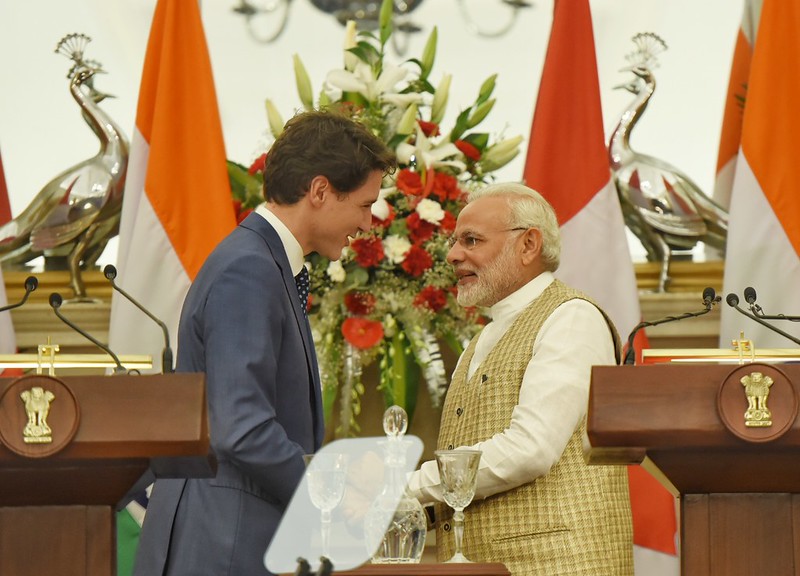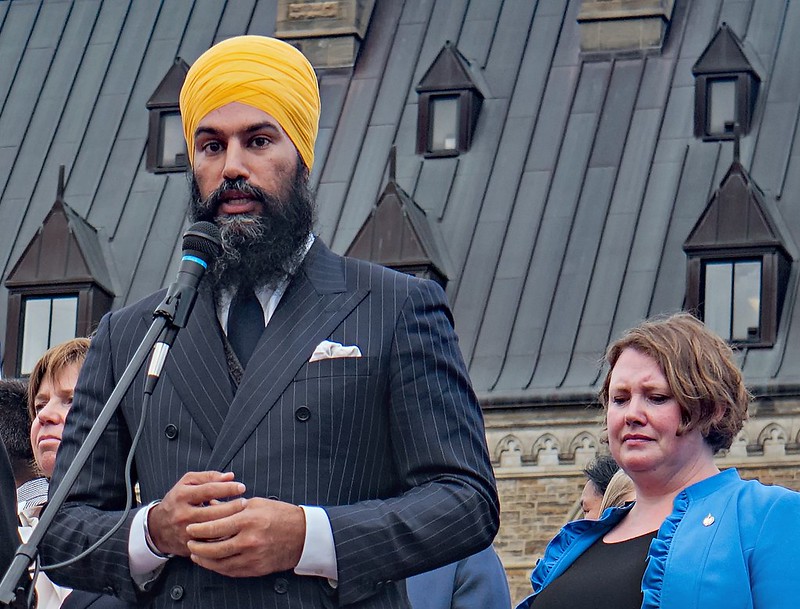
On September 18, 2023, Canadian Prime Minister Justin Trudeau accused India of the political assassination of Hardeep Singh Nijjar, a Canadian Sikh leader who had espoused the cause of Khalistan, a separatist movement that seeks to create a homeland for Sikhs. Trudeau’s accusations have since caused a diplomatic nightmare for the Narendra Modi led Indian government. India has rejected the claims, calling the allegations “absurd” and “motivated.” Further, in a tit-for-tat move, India and Canada have both expelled a diplomat, and India has temporarily stopped issuing visas to Canadians, citing “security threats” to its missions in Canada. Finally, Canada has withdrawn 41 diplomats from India after the latter sought parity in its diplomatic missions.
While the United States has reportedly provided Canada with ‘credible’ evidence against India and has privately asked the latter to cooperate in the investigations led by Canadian authorities, the United States has not publicly condemned India — a key partner in the Indo-Pacific and the United States’ bulwark against a rising China in Asia. This allegation has not only led to a diplomatic row between India and Canada, but it has also hampered people-to-people ties.
To resolve outstanding issues, Canada should address Canadian Khalistan supporters who act against Indian interests and extradite violent Khalistan supporters. Meanwhile, the Indian government should demonstrate sensitivity towards Sikh communities domestically and abroad and resolve their grievances amicably. Simultaneously, it should cooperate with the Canadian authorities during the investigations. Finally, both states must enhance their trade, commercial and military-to-military ties to ensure better bilateral relations.
Demand for Khalistan among the Sikh Diaspora
Despite the creation of a separate Sikh state (i.e. Punjab) in 1966 and the subsequent inclusion of Sikhs into the Indian establishment, especially the armed forces, resentment among fringe elements in the Sikh community have continued due to the supposedly truncated nature of their state.
Over the years, economic underdevelopment transformed into demands for political representation as the Khalistan movement acquired a militant tenor and spread across Punjab. Militancy followed from the siege of the Golden Temple during “Operation Blue Star”, the untimely death of Prime Minister Indira Gandhi, and the 1984 riots that saw bloodshed between Hindus and Sikhs with the latter being gravely affected. These traumatic events impacted the psyche of a section of diaspora Canadian Sikhs who ‘focused on gaining more recognition for Sikh suffering linked to events of 1984.’
…simmering tensions resurfaced following Trudeau’s Parliament speech, which members of the Canadian Sikh community viewed favorably, for it resuscitated their cause.
In recent times, a small section of these Canadian diaspora Sikhs, through mobilization campaigns, political referendums, acts of vandalism (such as temple desecrations) and political protests, have attempted to revive the Khalistan movement which had largely died out in the late 1980s. In this quest, gurudwaras (i.e. Sikh temples) have emerged as sites of political discourse in Canada as a means to influence the public discourse. In Nijjar’s case too, the gurdwara was used as a tool of weaponization as he used a Canadian gurdwara to lead the movement, recruit loyalists, and engage with anti-India terrorist organizations.
Moreover, rising support for the Khalistan movement in Canada, the increase in anti-India activities, and the back-to-back deaths of prominent Khalistani leaders in different countries over the last few months, have slowly brought the issue of Khalistan back into the public eye. Within this polarized setting, the Nijjar killing has acted as a tinderbox and blown the lid off a complex socio-political issue both in India and abroad.
In this scenario, simmering tensions resurfaced following Trudeau’s Parliament speech, which members of the Canadian Sikh community viewed favorably, for it resuscitated their cause. Meanwhile, India’s bipartisan condemnation of the speech brought India-Canada ties to a nadir.

Impact at the Federal Level
Today, the Khalistan issue strains India-Canada relations at the federal level. Tensions between India and Canada have flared in recent decades, with New Delhi persistently raising the Khalistan issue with Ottowa. In the name of “free speech” Canada has allowed Khalistanis to pursue their cause within its borders.
In fact, Canadian authorities have been accused of conducting lopsided investigations during the “Kanishka” incident — one of the world’s worst aviation terror attacks allegedly by a Khalistani separatist group — that killed 329 people. Families of the victims have felt alienated from the judicial process because of the lack of justice being meted out to them by the Canadian government.
Moreover, ties between India and Canada have soured since incumbent Canadian Prime Minister Trudeau has repeatedly engaged with pro Khalistan groups. His disastrous visit to India in 2018, and his recent lackluster outing that saw Trudeau being chided by Modi for his inaction on the Khalistan issue along the sidelines of the G20 summit, have caused ties to plummet further, since India has prioritized Canadian action on the Khalistan issue.
Unfortunately, Trudeau’s over-reliance on his coalition partner Jagmeet Singh from the New Democratic Party, has impacted his India policy. Since Singh and the New Democratic Party have expressed their support for Khalistan, Trudeau has appeased his coalition partner and the Canadian Sikh community without condemning anti-India activities.
Impact at the Societal Level
Friction in bilateral ties at the federal level has percolated down to the societal level, affecting people-to-people ties. The politicization of Nijjar’s death has revived international attention towards Khalistan and the Sikh community, both in India and abroad. Trudeau’s Parliament statement has increased the vulnerability of Sikh, Hindu, and other Indian communities, both in Canada and elsewhere.
Within India, this incident has brought the term ‘Khalistan’ back into the Punjabi public discourse with Punjabi Sikhs demanding redressal to the age-old conflict through the release of political prisoners. The Indian government has responded by attempting to curb Sikh separatist sentiments in India by confiscating properties and choking their finances under the Unlawful Activities Prevention Act (UAPA).
Friction in bilateral ties at the federal level has percolated down to the societal level, affecting people-to-people ties.
Envisaging Better Bilateral Ties
A multi-pronged approach is required to de-escalate the India-Canada tensions. Since India is a part of Canada’s Indo-Pacific strategy, Canada must develop a comprehensive India strategy. In fact, a military-to-military partnership can divert attention from the Khalistan issue and enable the amelioration of ties. India and Canada have set the precedent by participating in ‘Exercise Sea Dragon’ with the United States to increase interoperability between the navies by practicing anti-submarine warfare. The Canadian Deputy Army Chief’s visit to the Indo-Pacific Army Chief’s Conference in Delhi is a step in the right direction. India and Canada can bolster defense trade by creating an agency similar to the India-U.S. Defense Acceleration Ecosystem (INDUS-X) to facilitate greater defense industrial collaboration between India and Canada.
Canada should reinstate its trade mission to India and prioritize the Comprehensive Economic Partnership Agreement (CEPA). Bilateral trade remains minuscule with Indian imports at USD $4.42 billion and Canadian exports at just USD $2.21 billion. Moreover, India and Canada should sign the Canada-India Energy pact for Indian access to Canadian oil, natural gas, and, uranium. Finally, this impasse can end with India assisting Canadian authorities in the investigation process. Canada should not allow anti-India activities to take place on its soil. Similarly, India should de-securitize the issue within India and engage with Sikh communities in order to ensure lasting peace with the community.
Also Read: Can India-Canada Relations Move Beyond Sikh Separatism Concerns?
***
Image 1: PM Modi and PM Trudeau via Flickr
Image 2: Jagmeet Singh via Flickr


